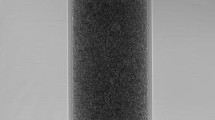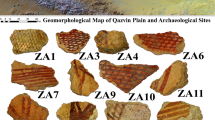Abstract
Synchrotron radiation micro computed tomography (SR Micro CT) and micro X-ray diffraction (SR Micro XRD) were used to investigate the deleterious effects of alkali-silica reaction (ASR) in mortar bars. The samples were prepared by mixing ordinary Portland cement and chert, the latter consists of quartz crystals known to be potentially alkali-silica reactive; then they are aged in a NaOH solution at 80 °C according to RILEM AAR-2 for ASR to occur. A characterization of the microstructural features (cracks, voids due to dissolution, aggregate detachment) due to ASR was performed by SR Micro CT and a detailed mineralogical characterization of the weathering layer growing at the cement paste-aggregate interface was conducted by SR Micro XRD. When ASR occurs, we observe the dissolution of the quartz belonging to aggregate followed by the precipitation of new crystals of quartz. On the other hand, when ASR aging increases the quartz dissolution is almost complete and a halo diffuse scattering dominates the XRD patterns. Furthermore, the ASR generated a widespread microcracking associated with irregular voids due to aggregate dissolution and a general detachment at the cement paste-aggregate boundary is observed.










Similar content being viewed by others
References
Stanton T (1940) Expansion of concrete through reaction between cement and aggregate. Proc Am Soc Civ Eng 66:1781–1811
Hobbs DW (1988) Alkali-silica reaction in concrete. Thomas Telford, London
Diamond S (1992) Alkali aggregate reactions (AAR) in concrete. An annotated bibliography 1939–1992: strategic highway research program report (SHRP-C/UWP-92-601)
Swamy RN (1992) The alkali-silica reaction in concrete. Blackie, Glasgow
Charlwood RG, Solymar ZV (1995) Long-term management of AAR affected structures: an international perspective. In: Proceedings of the 2nd international conference on alkali-aggregate reaction in hydroelectric plants and dams, Chattanooga, Tennessee. US Committee on Large Dams (USCOLD), Denver, Colorado (US), pp 19–55
Fournier B, Bérubé MA (2000) Alkali-aggregate reaction in concrete: a review of basic concepts and engineering implications. Can J Civ Eng 27:167–191
Broekmans MATM (2012) Deleterious reactions of aggregate with alkalis in concrete. In: Broekmans MATM, Pöllmann H (editors): Applied mineralogy of cement and concrete. Rev Mineral Geochem 74:279–364
Akasaki JL, Zoilo CS, Fioriti CS, Pereira AM, Bernardes HM, Salles FM (2013) Cracking due to alkali silica reaction in slab at the Jaguari hydroelectric power plant: a qualitative study. Rev Ing Construc 28:290–299
Majid CM, Chaudhry MN, Bhatti TJ (2013) Alkali silica reaction (ASR) potential of sand and gravels from NW-Himalayan rivers and their performance as concrete aggregate at three dams in Pakistan. Sci Int 25:893–899
Lindgård J, Nixon PJ, Borchers I, Schouenborg B, Wigum BJ, Haugen M, Åkesson U (2010) The EU “PARTNER” project—European standard tests to prevent alkali reactions in aggregates: final results and recommendations. Special Issue 13th ICAAR 2008, June 16–20, Trondheim, Norway. Cem Concr Res 40:611–635
Jensen V (2004) Alkali-silica reaction damage to Elgeseter Bridge, Trondheim, Norway: a review of construction, research and repair up to 2003. Mater Charact 29:155–170
Broekmans MATM (2004) Structural properties of quartz and their potential role for ASR. Mater Charact 29:129–140
Ichikawa T, Miura M (2007) Modified model of alkali-silica reaction. Cem Concr Res 37:1291–1297
Kim T, Olek J, Jeong HG (2015) Alkali-silica reaction: kinetics of chemistry of pore solution and calcium hydroxide content in cementitious system. Cem Concr Res 71:36–45
Bernard L, Leemann A (2015) Assessing the potential of ToF-SIMS as a complementary approach to investigate cement-base materials—applications related to alkali-silica reaction. Cem Concr Res 68:156–165
Turanli L, Shomglin K, Ostertag Monteiro PJM (2001) Reduction in alkali-silica expansion due to steel microfibers. Cem Concr Res 31:825–827
Thomas M (2011) The effect of supplementary cementing materials on alkali-silica reaction: a review. Cem Concr Res 41:1224–1231
Pan JW, Feng YT, Wang JT, Sun QC, Zhang CH, Owen DRJ (2012) Modeling of alkali-silica reaction in concrete: a review. Front Struct Civ 6:1–18
Saouma VE, Martin RA, Hariri-Ardebili MA, Katayama T (2015) A mathematical model for the kinetics of the alkali-silica chemical reaction. Cem Concr Res 68:184–195
Fernandes I, Ribeiro MA, Broekmans MATM, Sims I (2015) AAR-1.2—detection of potential alkali-reactivity of aggregates—petrographic atlas. Springer Verlag, Berlin-Heidelberg/DE, in press
Kurtis KE, Monteiro PJM, Jt Brown, Meyer-Ilse W (1998) Imaging of ASR gel by soft X-ray microscopy. Cem Concr Res 28:411–421
Kirkpatrick RJ, Kalinichev AG, Hou X, Struble L (2005) Experimental and molecular dynamics modeling studies of interlayer swelling: water incorporation in kanemite and ASR gel. Mater Struct 38:449–458
Hou X, Kirkpatrick RJ (2005) Structural investigations of alkali silica gels. J Am Ceram Soc 88:943–949
Tambelli CE, Schneider JF, Hasparyk NP, Monteiro PJM (2006) Study of the structure of alkali-silica reaction gel by high-resolution NMR spectroscopy. J Non-Cryst Sol 352:3429–3436
Benmore C, Monteiro PJM (2010) The structure of alkali silicate gel by total scattering methods. Cem Concr Res 40:892–897
Wieker H, Hubert C, Heidemann D, Ebert R (2000) Some experiences in chemical modelling of the alkali-silica reaction. In: Bérubé MA, Fournier B, Durand B (eds) Proceedings of the 11th international conference on alkali-aggregate reaction in concrete (ICAAR), Québec/CA, pp 119–128
Marinoni N, Voltolini M, Mancini L, Vignola P, Pagani A, Pavese A (2009) An investigation of mortars affected by alkali-silica reaction by X-ray synchrotron microtomography: a preliminary study. J Mater Sci 44:5815–5823
Marinoni N, Voltolini M, Mancini L, Cella F (2012) Influence of aggregate mineralogy on alkali-silica reaction studied by X-ray powder diffraction and imaging techniques. J Mater Sci 47:2845–2855
Voltolini M, Marinoni N, Mancini L (2011) Synchrotron X-ray computed microtomography investigation of a mortar affected by alkali-silica reaction: a quantitative characterisation of its microstructural features. J Mater Sci 46:6633–6641
RILEM AAR-2 (2015) Recommended test method AAR-2 detection f potential alkali-reactivity of aggregates—the ultra-accelerated mortar bar test. Special Issue RILEM TC219-ACS. Mater Struct (in press)
Marinoni N, Broekmans MATM (2013) Microstructure of selected quartz by XRD, and a critical review of the crystallinity index. Cem Concr Res 54:215–225
Humphries DW (1992) The preparation of thin sections of rocks, minerals and ceramics. Royal Microscopical Society, Oxford Science Publications, Oxford
Toby BH, Von Dreele RB (2013) GSAS-II: the genesis of a modern open-source all purpose crystallography software package. Appl Crystallogr 46:544–549
Herman GT (1980) Image reconstruction from projections. Elsevier, New York
Abramoff MD, Magelhaes PJ, Ram SJ (2004) Image processing with ImageJ. Biophotonics Int 11:36–42
Lutterotti (2010) http://www.ing.unitn.it/~maud/
Young RA (1993) The rietveld method. Oxford University Press, Oxford
Graetsch H (1994) Structural characteristics of opaline and microcrystalline silica minerals. In: Heaney PJ, Prewitt CT, Gibbs GV (editors) Silica: physical behavior, geochemistry and materials applications. Rev Mineral 29:209–232
Graetsch HA, Grünberg JM (2012) Microstructure of flint and other chert raw materials. Archaeometry 54:18–36
CUR-Recommendation 89 (2008) Measures to prevent concrete damage by the alkali-silica reaction. Official English translation, 2nd rev edn. Centre for Civil Engineering Research and Codes, Gouda
Heaney PJ, Post JE (1992) The widespread distribution of a novel silica polymorph in microcrystalline quartz varieties. Science 255:441–443
Klug HP, Alexander LE (1974) X-ray diffraction procedures, 2nd edn. Wiley, New York
Taylor HFW (1997) Cement chemistry, 2nd edn. Thomas Telford, London
Acknowledgements
We acknowledge the European Synchrotron Radiation Facility for provision of synchrotron radiation facilities and we would like to thank Dr. Aurélien Gourrier for his assistance in using beamline ID13 (Experiment Number: 21774). The authors also thank SYRMEP Group at ELETTRA Synchrotron for their support.
Author information
Authors and Affiliations
Corresponding author
Ethics declarations
Conflict of interest
The authors declare that they have no conflict of interest.
Rights and permissions
About this article
Cite this article
Marinoni, N., Voltolini, M., Broekmans, M.A.T.M. et al. A combined synchrotron radiation micro computed tomography and micro X-ray diffraction study on deleterious alkali-silica reaction. J Mater Sci 50, 7985–7997 (2015). https://doi.org/10.1007/s10853-015-9364-7
Received:
Accepted:
Published:
Issue Date:
DOI: https://doi.org/10.1007/s10853-015-9364-7




